Educational attainment is an important element of human capital; however a series of recent papers highlights the crucial role of the quality of education—which determines the skills actually learned, rather than the number of years spent in a classroom—as a main driver of growth. In fact, Hanushek and Woessmann argue that the importance of more appropriately measuring skills is seen in the very tight relationship between quality of skills, or knowledge capital, and growth. Moreover, the researchers state, “The knowledge capital–growth relationship suggests little mystery for East Asia, Latin America, or other regions: Growth rates are accounted for by cognitive skills.” Similarly, “Considering knowledge capital dramatically increases our ability to account for differences in growth.”
Given the evidence of the importance of knowledge capital, we believe that looking at this dimension is extremely informative in a comparison of Puerto Rico with the continental United States, as well as with some meaningful comparison countries. We want to understand whether Puerto Rico has the opportunity to enhance its economic growth prospect by improving the quality of its human capital.
The Quantity of Human Capital
In the chart below we look at the educational attainment of Puerto Ricans twenty-five years to fifty-four years old in 2013, in comparison to their peer group on the U.S. mainland. In terms of educational attainment, the prime age population in Puerto Rico and the U.S. mainland are fairly comparable. However, economic growth has been consistetly slower in Puerto Rico than in the U.S. mainland; one reason, as noted, may be that years of schooling are just a proxy for human capital and, given the importance of the quality of education in explaining growth, we want to look deeper.
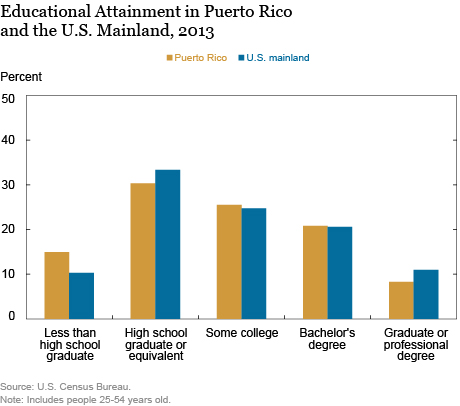
The Quality of Education
Puerto Rico in an International Comparison
A sample of 1,668 students from fifty-six public and private schools in Puerto Rico participated in the PISA test for the first time in 2012. The test is designed to capture the quality of human capital and the ability to perform specific tasks in an internationally comparable setting. From the PISA website: “The Programme for International Student Assessment (PISA) is a triennial international survey which aims to evaluate education systems worldwide by testing the skills and knowledge of 15-year-old students. To date, students representing more than 70 economies have participated in the assessment.”
Although the PISA test is designed and implemented by the Organization for Economic Cooperation and Development (OECD), this first edition of the PISA test in Puerto Rico was implemented by the Puerto Rico Department of Education (PRDE) while facilitated by the National Center for Education Statistics (NCES). Our analysis focuses on the statistics published in this report. Because this is the first implementation, we believe some caution is needed in interpreting the statistics below. However, they align with the National Assessment of Educational Progress (NAEP) results as we will see below, further these statistics have been widely discussed by various media outlets, including the Puerto Rican press on several occasions.
In this post we focus on the mathematics test score, which has been shown to be a good predictor of future labor market outcomes. Among the sixty-six countries and territories and three U.S. states that participated in the PISA test in 2012, the average score in Puerto Rico is fifth from the bottom, with only Colombia, Qatar, Indonesia, and Peru having worse scores. In the figures below we present the results for the top scorer, the U.S. mainland and participating states, the overall average, and for Puerto Rico and twelve “peer” countries closest to Puerto Rico in terms of GDP per capita in 2012.
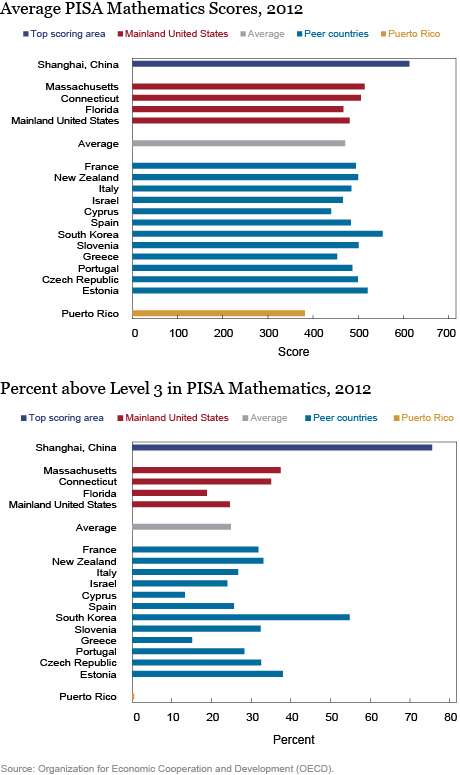
In fact, in Puerto Rico virtually none (less than 1 percent) of the sampled students scored above level 3, which is generally considered a basic proficiency level, on the PISA test. To have a sense of what that level entails, the NCES offers the following characterization:
At Level 3 [lowest score 482, about 54.5 percent of students perform at or above this level], students can execute clearly described procedures, including those that require sequential decisions. Their interpretations are sufficiently sound to be a base for building a simple model or for selecting and applying simple problem-solving strategies. Students at this level can interpret and use representations based on different information sources and reason directly from them. They typically show some ability to handle percentages, fractions and decimal numbers, and to work with proportional relationships. Their solutions reflect that they have engaged in basic interpretation and reasoning.
In comparison, the highest PISA mathematics proficiency level is described as follows:
At level 6 [lowest score 669, only 3.3 percent of students score at or above this threshold in the PISA sample], students can conceptualize, generalize and utilize information based on their investigations and modelling of complex problem situations, and can use their knowledge in relatively non-standard contexts. . . .
Puerto Rico in a National Comparison
The NAEP is the “largest nationally representative and continuing assessment of what America’s students know” in a variety of subjects. In 2015, representative samples of 137,400 fourth-grade and 135,100 eighth-grade public school students from all fifty states and the District of Columbia completed the NAEP. From private schools, representative samples of 2,400 fourth-grade and 2,300 eighth-grade students completed the exam.
In Puerto Rico, representative samples of approximately 4,700 fourth-graders from 160 public schools and 5,100 eighth-graders from 120 public schools participated in a Spanish-language version of the NAEP mathematics assessment in 2015. Students in Puerto Rico participated in the NAEP in 2003, 2005, and 2007, but due to improved data quality, the exam results from 2011 through 2015 provide the most meaningful comparison with the U.S. mainland.
In the charts below, we compare the performance of Puerto Rican students on the 2011, 2013, and 2015 mathematics assessments with their peers in the nation overall and with those eligible for the National School Lunch Program (NSLP). Because virtually all public school students in Puerto Rico are eligible for free or reduced-price lunches, NSLP students constitute the more relevant comparison group. Fourth- and eighth-grade mathematics performance is reported as average scores on a 0 to 500 scale and as percentages of students scoring at or above three achievement levels (basic, proficient, and advanced). Average mathematics scores for students in Puerto Rico, as well as those for public school students overall and NSLP eligible students, were little changed from 2013 to 2015.
The basic achievement level denotes: “Partial mastery of prerequisite knowledge and skills that are fundamental for proficient work at each grade.” As the charts below show, 89 percent of Puerto Rican fourth-graders, and 94 percent of the eighth-graders scored below the basic level in 2015. In contrast, in the nation as a whole 28 percent of NSLP fourth-graders, and 42 percent of the eighth-graders scored below the basic level in 2015. Results in 2011 and 2013 were similar. Thus, mathematics performance of Puerto Rican students lags far behind their mainland peers.
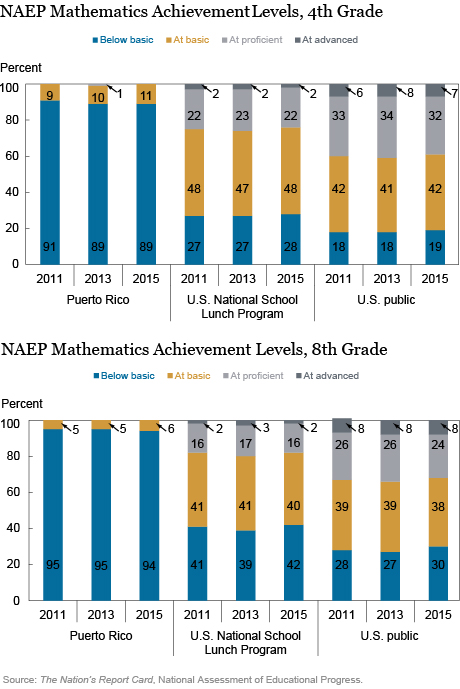
In the maps below, we examine how Puerto Rico stacks up against individual states, as measured by the percentage of students scoring at or above the proficient level in NAEP math. Again, Puerto Rico lags dismally behind all states. In fourth-grade math, Alabama and New Mexico are the lowest scoring states as measured by this indicator, with 26 percent and 27 percent of their students, respectively, scoring at or above proficient. In contrast, this number is 0 percent in Puerto Rico. In eighth-grade math, Alabama and Louisiana were the lowest scoring at 17 percent and 18 percent respectively. In contrast, no sampled Puerto Rican eighth-grader scored in the proficient category.
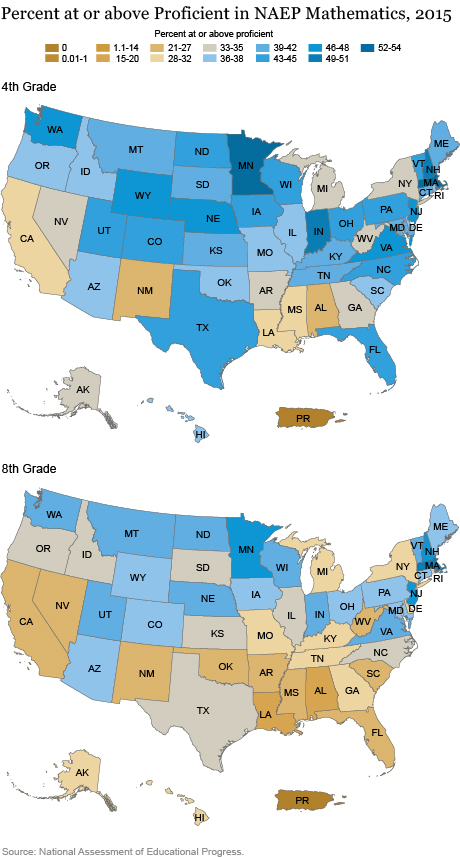
Conclusions
The test results for both PISA and NAEP are alarming, and even more so given the migration trajectories out of Puerto Rico. The very slow growth of Puerto Rico seemed puzzling given previous estimates of the quantity of human capital—as proxied by the number of years of schooling—and its contribution to growth. However, this slow economic growth is in fact consistent with the evidence on the quality of human capital highlighted in this blog. As a caveat, the test scores cited here reflect the human capital of students who have not yet entered the labor force, so this analysis relies on the assumption that these poor educational outcomes persist. It seems clear, nonetheless, that boosting educational performance can help Puerto Rico substantially in establishing future economic growth.
Disclaimer
The views expressed in this post are those of the authors and do not necessarily reflect the position of the Federal Reserve Bank of New York or the Federal Reserve System. Any errors or omissions are the responsibility of the authors.

Rajashri Chakrabarti is a senior economist in the Federal Reserve Bank of New York’s Research and Statistics Group.

Giacomo De Giorgi is a senior economist in the Bank’s Research and Statistics Group.
 Rachel Schuh is a senior research analyst in the Bank’s Research and Statistics Group.
Rachel Schuh is a senior research analyst in the Bank’s Research and Statistics Group.
How to cite this blog post:
Rajashri Chakrabarti, Giacomo De Giorgi, and Rachel Schuh, “Human Capital and Education in Puerto Rico,” Federal Reserve Bank of New York Liberty Street Economics (blog), August 11, 2016, http://libertystreeteconomics.newyorkfed.org/2016/08/human-capital-and-education-in-puerto-rico.html.










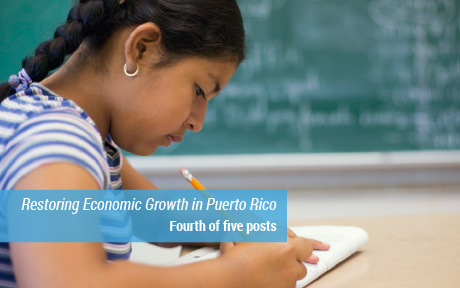
 RSS Feed
RSS Feed Follow Liberty Street Economics
Follow Liberty Street Economics
In reply to Charles Steindel: Thank you very much for this good question. It is indeed hard to tell apart the simple correlation from the causal link between human capital or knowledge capital and economic growth. There are, as one might expect, several reasons why this simple correlation, which has been robustly established at the cross-country level in several articles might not translate to a causal statement. However, the literature cited in the post makes important strides in that direction, in particular addressing some of the most relevant concerns such as reverse causality or omitted factors that would cause both high quality of education in terms of test results and economic growth. While it is still possible that, at least partly, that relation has not causal interpretation, the amount of evidence cumulated over the past decades of research appears consistent with there being a causal link between quality of education and economic growth. And our statement is based on this literature, as we have tried to clearly indicate in our post.
The Dept of Education in PR, which controls all public schools, is responsible for these dismal results. The Federal Government finances about 50 percent of the annual spending of the Education PR, which must follow federal regulations. The time has come for Congress to demand better educational outcomes for the millions spent in public schools in PR.
While this is interesting, the implicit assumption that there is a marked causal connection between educational achievement of this type and economic development is questionable. Looking at the state results, California is quite poor; yet the state has seen pretty strong growth in recent years and is, of course, one of the wealthiest in the nation. New York is, to put it politely, mediocre on this count but has also seen a very strong recovery. New Jersey, I’m chagrined to note, is decidedly better on the educational front but the state’s economic performance has been fairly lackluster for the last generation. In any event, even if the correlation can be demonstrated, the causal linkage can well be from economic achievement to school improvement.